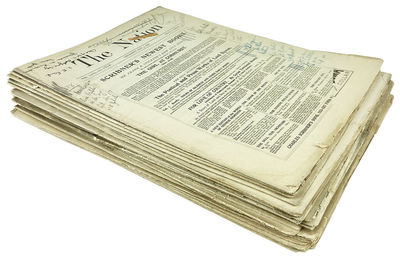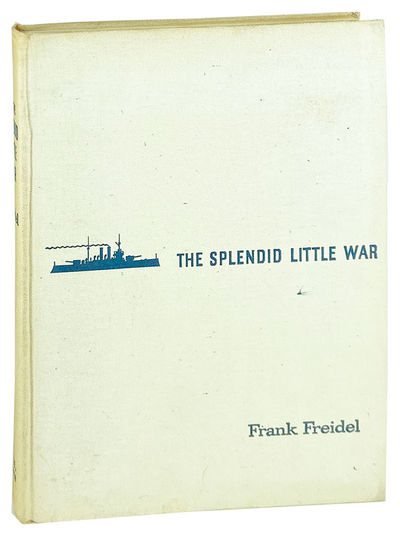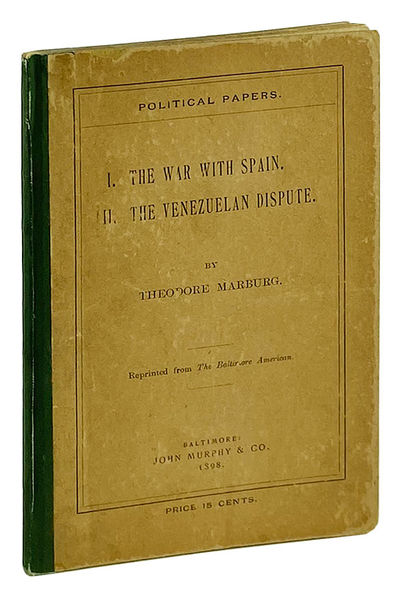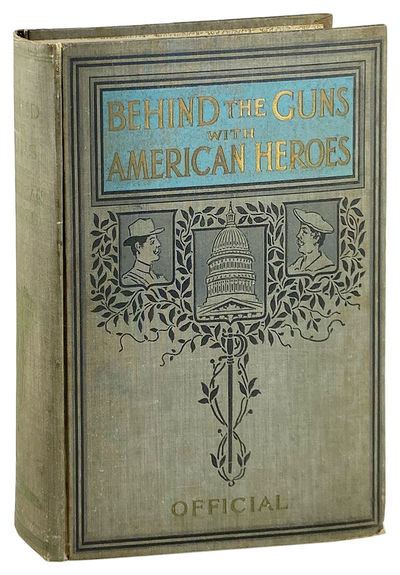
ACCADEMIA DELLA CRUSCA
Vocabolario degli Accademici della Crusca. Impressione napoletana secondo l’ultima di Firenze con la giunta di molte voci raccolte dagli autori approvati dalla stessa Accademia
Napoli: A spese di Giuseppe Ponzelli / Nella stampería di Giovanni di Simone, 1746
- $2,750
Napoli: A spese di Giuseppe Ponzelli / Nella stampería di Giovanni di Simone, 1746. Six volumes in five; folio (42.5cm.); uniformly bound in full contemporary vellum, gilt spine lettering, all edges speckled grey and orange; collated and complete (collation available upon request); engraved illus., head- and tail-pieces, and initials throughout. Minor wear, chiefly at corners, textblock occasionally rather foxed and darkened from exposure to ink, else a Very Good, quite attractive set of this superlative edition. Updated edition of this monumental dictionary first published in 1612 after nearly thirty years of research (the Accademia itself was founded in 1583). Like most Renaissance dictionaries of vernacular language, the "Vocabolario" laid a heavy emphasis on the written language and usage of Florentine authors of the 15th century, entirely excluding the spoken language and dialects of the lower and craft classes. This edition, published the year Voltaire joined the Accademia, finally broke the mold of its predecessors. Under the guidance of signor Don Pasquale di Tommasi, the "Vocabolario" was finally "enriched with so many words overlooked by Florentine scholars" (Ferdinando Galiani in his preface to the second edition of "Della Moneta"). Not just an improvement on earlier examples, the Naples edition is one of exceptional beauty, adorned throughout with engraved vignettes blending words found in the present volume, often in humorous and imaginative ways (a fluffy, possum-like animal rooting through a cloud of flour: "Grufolando infarinato"). VANCIL, p. 2.
More from L.N. Golay Books

Afternoon With a Geisha
[DRAMA & FILM - ODORI] AZUMA HARUE [a.k.a. Azuma Tokuho] N.p., 1954 N.p., 1954. Small quarto (26cm.); hand-made volume of black paper-covered boards, original photographic element mounted to upper cover; [18]ll. to which are mounted seventeen (17) original black and white photographs captioned with photo-reproduced text from typescript. Boards slightly worn with brief chipping of paper to upper cover and at spine ends, textblock uniformly toned due to inferior paper quality, one photograph separated but present. Overall Very Good. Possibly unique photo-essay depicting the preparation for and performance by Japanese dancer Azuma Harue (1909-1998). The daughter of fellow-performers Ichimura Uzaemon and Masaya Fujima, by 1942 Azuma had succeeded her father as a second-generation Soke (Grand Master) of "kabuki" dance, despite the field's exclusion of women performers. This album presumably compiled by an Western journalist or audience-member, possibly dating from the Azuma Company's 1954 tour of the United States. The text opens with a brief introduction of the performer, who began "at the age of six to study the dance of the body, feet, arms and hands...These pictures show Harue Azuma making up and dressing with the aid of her maid prior to posing in various forms of the odori." The opening photograph's caption reveals the nature of the album's compiler. In the image Azuma is applying a layer of white make up to her face, which the text describes as "Dead white on yellow - the makeup begins." The following seven images show Azuma preparing her hair for her headress and wig with the aid of her servant, applying "lotus petal lipstick," and painting her finger nails. The remaining ten photographs show Azuma on an empty stage before a drawn curtain in various poses, including "Mood of the Ocean Waves," "Fanfare Frieze," "Fanciful Flutter," "Sudden Summer Shower," and finally "Nipponese Salome." A wonderful portrait of one of the greatest performers of Japanese dance of her generation.- $450
- $450
![[Text in Russian] Atlas Trinadtsati Chastei S. Peterburga s podrobnym izobrazheniem naberezhnykh](https://rarebookinsider.com/wp-content/uploads/2022/06/1473437318.0.l.jpg)
[Text in Russian] Atlas Trinadtsati Chastei S. Peterburga s podrobnym izobrazheniem naberezhnykh, ulits, pereulkov, kazennykh i obyvatel’nykh domov [WITH] Alfabitnyi ukazatel’ k Atlasu 13-ti chastei S. Peterburga [An Atlas of the Thirteen Parts of St. Petersburg with a detailed image of its embankments, streets, alleyways, and town houses [WITH] An Alphabetical Index] [Inscribed and Signed to Dmitry Yegorovich Benardaki]
TSYLOV, Nikolai Ivanovich St. Petersburg, 1849 St. Petersburg: s.i., 1849. First Edition. Two volumes; small quarto (26.5cm.); uniformly bound in publisher's blind-ruled purple cloth, gilt-lettered spines; atlas volume includes 392 numbered street plans as well as one hand-colored map of the city and 13 hand-colored district maps (collated and complete); index volume: [6],279,[1],39pp. Cloth extremities rather faded, spines uniformly sunned to tan, a few plates trimmed a bit close touching numbers, else a Very Good, internally fine set of the first atlas of St. Petersburg, albeit lacking errata leaf. Front free endpaper of the atlas inscribed and signed by Tsylov "To Dmitry Yegorovich Benardaki / With the sincerest devotion / From the author / Nikolai Tsylov"). The seed of St. Petersburg was first planted in 1610 as a small but powerful fortress built where the Neva meets the Okhta River. The Swedish, having recently annexed a large swathe of land from the Russians during the "Smuta" (a.k.a. the Time of Troubles, 1598-1613), were in need of a stronghold to preserve their rule over the newly-acquired region of Ingria and thus Nyenschantz was built. For almost a hundred years the fortress remained under threat of invasion, rebuffing at least one major attack, in 1656. By the mid-1670s the fortress had been modernized and expanded to house as many as six hundred. But while the Swedish saw the location as a protective measure, Peter the Great saw something much more powerful: a gate to the Western world. By 1700 the Great Northern War had broken out and by 1703 the fortress had fallen and Ingria was once again Russian soil. With deliberation Peter the Great made plans to establish a city on the estuary of the Neva River, and that city would be the new capital of Russia, St. Petersburg. Situated as a port town and a link between Russia and the West, St. Petersburg was for the next two hundred years a cosmopolitan and Western-looking capital city, while Moscow came to represent Russia's medieval and Orthodox origins. Fittingly, the first topographical description of the city, which appeared in 1713, was published not in Russia, but in Leipzig, anonymously, and in German. Speculation has been made that the work was commissioned by Peter himself, who saw the need to paint a positive portrait of the city amongst his Western peers. Apparently he saw no need to win over his own subjects, and for much of the 18th century there remained a dearth of secular Russian literature, printed in Russia, about Russia. The first full-length book about St. Petersburg in Russian arrived on the scene in 1749 by the hand of a zealous librarian named Andrei Bogdanov, but his oversized folio was never published. The most popular description of the city published in the 18th century was by a German, Johann Gottlieb Georgi. The title translates as "Description of the Russian Imperial Capital City St. Petersburg and the Memorable Sites in Its Suburbs, with a Map" (1794), and included detailed descriptions of the school, churches, hospitals, charitable institutions, and government agencies throughout the city. The work was hugely influential, saw several editions in its original German, as well as a French translation, but most importantly, it was translated into Russian. Its thumbprint can be seen on Tsylov's atlas. Between the publication of Georgi's "Description" and Tsylov's "Atlas," however, another sixty years and the Napoleonic Wars intervened. St. Petersburg had now been scrutinized by Fyodor Dostoevsky and Nikolai Gogol, among others, yet some still decried the lack of literature devoted exclusively to the city itself. Significantly, in 1845, a leading member of the Westernizing faction of Russia's budding intelligentisia named Vissarion Belinsky, published an anthology titled "A Physiology of Petersburg," in which the author accused Russian society of missing proper "belletristic works in the form of travel narratives, [puteshestriviia], accounts of tours [poezdki], sketches, stories, and geographic descriptions [opisaniia] that would acquaint [the public] with the various parts of boundless and diverse Russia" (cf. Emily D. Johnson, "How St. Petersburg Learned to Study Itself" (2006), p. 35). In the next five years a flood of travelogues and topographical studies appeared on the market, best among them the first atlas of St. Petersburg, compiled by the high-ranking officer Nikolai Ivanovich Tsylov (1801-1879). Tsylov's atlas was born of a smaller such work he had compiled, of a single district of the city. This had been received with such warmth that he felt compelled to produce the present work, a democratic and nearly microscopic depiction of the city in which the street plans are even demarcated by building materials (stone, wood, or a mix). The atlas is accompanied by a substantial index of the buildings, including a directory of the major townhouses, their inhabitants, and even the number of floors (rarely exceeding four). Of special note are the thirteen maps preceding each section, expertly hand-colored in all extant copies. Based on auction records and library holdings it can be surmised that very few sets were issued, possibly by subscription or privately: of the three copies located in OCLC (Harvard, NYPL, Wisconsin) at least the Wisconsin copy is also inscribed by Tsylov. NUC adds a copy at the Library of Congress; COPAC adds copies at the British Library and Cambridge. Provenance: Inscribed and signed by the author to Dmitry Yegorovich Benardaki (sometimes spelled Dmitrii Egorovich) (1799-1870), presumed to be the inspiration for Murazov in Nikolai Gogol's novel "Dead Souls." Already in the 1830s Benardaki had amassed an enormous fortune through speculation on wheat. He was first introduced to Gogol by the Russian historian Mikhail Pogodin, a relationship rather novelistically described by Henri Troyat in his biography of Gogol "Divided Soul" (1973): "From [Benardaki's] conversation...Gogol discovered the ruthless world of competition and profit, and the struggle for market control. The eloquent and astute Benardaki became for him a personification of the practical man. The Russian of the future must be modeled upon this man. What a fine character for a novel this Christian millionaire would make!" (p. 200). A rather more grounded description of the relationship can be found in David Christian's article "The Neglected Great Reform," published in "Russia's Great Reform, 1855-1881") (1994). According to Christian, Benardaki loaned Gogol some money in 1839 "and it may be that a grateful Gogol took him as his model for the virtuous tax farmer Muzarov" (p. 113). In any case, Benardaki's 1863 patent of nobility sold at Sotheby's in 2007 for an eye-watering sum.- $18,500
- $18,500

Anatomy, Descriptive and Surgical
GRAY, Henry; H.V. Carter, illus Philadelphia, 1862 Philadelphia: Blanchard and Lea, 1862. Second American from the Revised and Enlarged London Edition. Large octavo (26cm.); publisher's full sheep, black gilt-lettered spine label; xxxii,[33]-816pp.; hundreds (395 to be exact) woodcut illus. throughout. Leather quite scuffed with some peeling along margins, most notably to upper cover, old dampstain along bottom edge of upper cover slightly bleeding into early preliminaries, several contemporary pencil ownership inscriptions to front free endpaper, as well as 20th century ownership rubberstamp to front free endpaper and dedication page. Overall a Good to Very Good copy, internally clean and sound. The most comprehensive, and as yet enduring, medical textbook produced by the modern Western world. Rather than run the risk of hyperbolizing, we've turned to the academics to do it for us: "[T]his workhorse of medical pedagogy has remained in everyday use far longer than any medical instruction manual of modern times, and is likely to go on, and on, and on--as far as the futuristic eye can see. [The 39th edition, from 2014] out-lives one after another of its now-huge stable of editors, even though much of the text in its pages, and a great multitude of its illustrations, have not significantly changed since its original publication in 1858" (Sherwin Nuland, "Books and Men, Redux," in "Proceedings of the American Philosophical Society," Vol. 158, no. 1, March, 2014, p. 7).- $2,250
- $2,250

Leonard Wood: A Biography
[WOOD, Leonard] HAGERDORN, Hermann New York, 1931 New York: Harper & Brothers Publishers, 1931. First Edition. Two volumes; large octavos (24.5cm.); publisher's cloth in uniform white photo-illustrated dust jackets, Vol. I retaining original price ($10), Vol. II price-clipped, grey topstain; xii,[2],436; viii,[2],524pp.; portrait frontispieces, fourteen leaves of photographic illus. printed on rectos and versos. Light wear to cloth extremities, jackets a bit chipped and worn at margins including a few small losses and occasional closed tears touching text without loss of meaning, general dust-soil, else a Very Good, sound set overall. Massive biography of American colonial administrator General Leonard Wood (1860-1927), a key player in the governance of the Philippines following the Spanish-American War.- $150
- $150

A History of Military Government in Newly Acquired Territory of the United States
THOMAS, David Yancey New York, 1904 New York: Columbia University Press, 1904. First Edition. Octavo (24.5cm.); contemporary tan library cloth, spine lettered in black, grey topstain; 334,[12](ads)pp. Ex-George C. Marshall Research Library with their markings throughout, cloth a bit finger-soiled, spine toned, else Good to Very Good. At head of title page: Studies in History, Economics and Public Law, Vol. XX, no. 2. Text chiefly devoted to Florida, New Mexico, and California, though the final chapter covers the Philippines, Puerto Rico, Samoa, and Panama following the Spanish defeat during the Spanish-American War.- $60
- $60

The Last Spanish War: Revelations in “Diplomacy
FERRARA, Orestes; William E. Shea [trans.] New York, 1937 New York: Paisley Press, 1937. First American Edition. Octavo (22.5cm.); publisher's cloth in pale grey price-clipped dust jacket lettered in red; [2],151pp. Light shelf wear, rather extensive paper flaw along bottom quarter of upper jacket panel somewhat affecting imprint, brief ink stains to bottom textblock edge, contemporary gift inscription to front free endpaper, else a Very Good, internally clean and sound copy overall. The former Cuban Ambassador to the United States Orestes Ferrara's take on the Spanish-American War, as well as a scathing exposé on the treachery of European diplomatic practices. Arguably translated and published in the United States as part of the isolationist literature that had begun to circulate as events in Europe were worsening. From the rear jacket panel: "[The Last Spanish War] goes far to justify the numerous Americans, [sic] who believe that the United States must maintain its traditional aloofness from foreign entanglements." Perhaps significantly, the gift inscription in this copy written by a Lieutenant (Junior Grade), United States Navy Reserve, to his "Pa," March 20, 1942.- $50
- $50

Broken Run of Twenty-Two Issues of “The Nation
[SPANISH-AMERICAN WAR] New York, 1899 New York: The Nation, 1899. First Edition. Twenty-two volumes; quartos (30.5cm.); uniformly stitched self-wrappers. Collection comprises the following issues: Nos. 1714 (May 5, 1898), 1716-19, 1721, 1724, 1730-2, 1734, 1736-7, 1746-7, 1751-2, 1754, 1762-3, 1766, & 1770 (June 1, 1899). Condition ranges from Near Fine to Good only, with a few of issues starting to split at spine, two issues with upper covers separated but present, and the earliest issue with rather large loss along bottom margin affecting text of the publisher's ads; additionally, most have contemporary pencil marginalia to upper covers. A substantial collection covering the major events of the Spanish-American War, the earliest issue opening with General Dewey's "annihilation" of the Spanish fleet in the Philippines in early May. However, as sick and wounded troops began to return and the conditions of the war came to light, the weekly news magazine's tone shows a marked shift. Within a couple of weeks, the magazine's pro-expansionist articles had shifted entirely in the opposite direction, and by September 8th the opening segment begins: "The sad condition of our returning troops has raised this inquiry to the minds of those whom Mr. Lincoln called 'the plain people': If we cannot administer affairs in our own territory better than Camp Algers, Thomas, Wikoff, and Black have been administered, how are we likely to administer the Philippine Islands ten thousand miles away?" Indeed, the coverage of the Treaty of Paris on December 10th speaks to the disillusionment wrought by the war. The opening segment on December 15th begins: "The treaty has been signed at last and we are in possession of Cuba, Porto Rico, and as much of the Philippines as the Spaniards possessed, which is not much.- $150
- $150

The Policy of Imperialism: Address by Hon. Carl Schurz at the Anti-Imperialist Conference in Chicago, October 17, 1899
SCHURZ, Carl Chicago, 1899 Chicago: American Anti-Imperialist League, 1899. First Edition. Octavo (21cm.); publisher's pale green wrappers (evidence of having been removed from larger volume); 27pp. Wrappers toned to tan, stock quite brittle with a few tiny chips at corners; Good to Very Good overall. Issued as Liberty Tracts no. 4.- $35
- $35

The Splendid Little War
FREIDEL, Frank Boston, 1958 Boston: Little, Brown and Company, 1958. Second Printing. Quarto (27cm.); publisher's white pictorial linen stamped in blue; [6],314pp.; photographic frontispiece, illus. throughout. Corners bumped, spine rather toned, ownership rubberstamp to front pastedown, else Very Good, internally clean and sound. Extensive and quite lavishly-illustrated popular history of the Spanish-American War, published two years after Freidel's monumental three-volume biography of Franklin Delano Roosevelt.- $50
- $50
![[Sammelband] Military Notes on Cuba [Bound With] Staffs of Various Armies](https://rarebookinsider.com/wp-content/uploads/2022/04/1467641278.0.l.jpg)
[Sammelband] Military Notes on Cuba [Bound With] Staffs of Various Armies
UNITED STATES WAR DEPARTMENT Washington DC, 1899 Washington DC: Government Printing Office, 1899. Mixed Editions. Octavo (24cm.); two volumes bound in one; contemporary cloth-backed marbled boards, gilt-lettered spine, original blue printed wrappers of both titles bound in; x,507; 231pp.; tables throughout. Ex-Cornell University Library with their extensive contemporary markings, including gift ex libris from the U.S. War Department, some general minor edge wear with brief exposure at board margins, else a Very Good, still quite sturdy copy. "Military Notes on Cuba" is described as a revised edition in the introductory notes, while "Staffs of Various Armies" is a first edition. Extensive colonialist description of Cuba composed in the wake of the Spanish-American War, providing brief overviews of the country's climate ("Hurricanes may occur from August to October"); Diseases and Hygienic Measures ("The worst place for foreigners on their arrival in Cuba is the coast, and the important cities are generally located along the worst part of the coast"); and Fruits ("The fruits of Cuba are numerous and delicious"). The majority of the text is then divided geographically, beginning with the city of Habana.- $175
- $175

Cuba and the Cubans
CABRERA, Raimundo; Laura Guiteras, trans.; Louis Edward Levy, ed Philadelphia, 1896 Philadelphia: Levytype Company, 1896. First American Edition. Octavo (20cm.); publisher's blue pictorial cloth stamped in gilt; xvi,17-442pp.; sixteen leaves of illus. printed on rectos and versos, color folding map bound in rear, dozens of engravings in text throughout. Cloth sizing rather rubbed at margins, spine panel and gilt quite dulled, some offsetting to endpapers, else Very Good, internally clean and sound overall. Biographical history of Spanish colonial Cuba, published just two years before the hostilities broke out between Spain and the United States. Chapters and biographies are divided by industry, including hospitality, journalism, law, literature, and local government.- $125
- $125

Political Papers. I. The War With Spain. II. The Venezuelan Dispute
MARBURG, Theodore Baltimore, 1898 Baltimore: John Murphy & Co, 1898. First Thus. Small, slim 12mo (17cm.); publisher's green cloth-backed paper-covered boards, upper cover printed within double rule; 50pp. Light wear to extremities including brief exposure at margins, boards lightly dust-soiled, else Very Good, internally clean and sound. Printed compliment card from the author bound in at head of volume. Two short articles by the American diplomat, both originally published in the periodical "The Baltimore American.- $85
- $85

Behind the Guns with American Heroes: An Official Volume of Thrilling Stories, Daring Deeds, Personal Adventures, Humorous Anecdotes, and Pathetic Incidents of the Spanish-American War and our battles with the Philippine Insurgents
BUEL, J.W. Chicago, 1899 Chicago: International Publishing Company, 1899. Large octavo (24.5cm.); publisher's grey pictorial cloth stamped in black, gilt, and blue; [2],x,33-503pp.; double-paged frontispiece printed color lithograph, myriad illus. throughout. Some general edge wear, bottom corners rather heavily bumped, spine gilt significantly dulled, rear cover bowed and spotted, front hinge cracked; a Good copy overall, though contents remain clean and sound.- $40
- $40
Vocabolario degli Accademici della Crusca. Impressione napoletana secondo l’ultima di Firenze con la giunta di molte voci raccolte dagli autori approvati dalla stessa Accademia: https://rarebookinsider.com/rare-books/vocabolario-degli-accademici-della-crusca-impressione-napoletana-secondo-lultima-di-firenze-con-la-giunta-di-molte-voci-raccolte-dagli-autori-approvati-dalla-stessa-accademia/